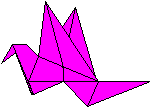| Origami Heaven A paperfolding paradise The website of writer and paperfolding designer David Mitchell
|
|||||||||||||
|
|||||||||||||
 |
|||||||||||||
| By
folding paper. There's no other way. You can learn to fold just by picking up a piece of paper and finding out for yourself what folding paper will do. This is great fun, and some of the world's greatest paperfolders learned their craft in precisely this way, but most people find it easier to learn by reproducing some of the wonderful designs that other paperfolders have already discovered. You would probably like to start by folding something truly awe inspiring. But, of course, it's always best to start simple. It also helps if a good result is virtually guaranteed. For both these reasons the very best designs for absolute beginners to fold are probably still the old favourites such as the Cicada and Pencil. You can find easy to follow diagrams for some simple-to-fold designs here. If you can learn to fold these designs well you will be ready to move on to other (though not necessarily better) things. You may also come to agree with me that the essence of origami is simplicity and elegance (how well the folding sequence flows) rather than complexity and that truly awe inspiring result. There is no substitute for practice, but here are a few hints and tips that might help you along the way: Choose the right surface to fold on: To fold paper accurately you need something flat, smooth and reasonably solid to rest on. You also need to be comfortable. A table-top or breakfast-bar is ideal, or, if you prefer to relax in an arm-chair you can make do with a coffee-table style hard-back book laid on your knees. Always fold on a surface. Folding in the air is a skill that comes with practice. It isn't the best way to start. Choose the right paper for the design. See What kind of paper should I use? There is an important difference between a fold and a crease. A fold is just a change of direction, a bend, in the paper. A crease is what you get when you completely flatten that bend. When origami diagrams (see How do I learn to understand origami diagrams?) tell you to make a fold that is usually shorthand for make a fold and flatten it to make a crease. Unless you are told otherwise it is always best to make your creases really sharp ones. You can use your fingernails for this, or, if your finger nails are too short, or worn out from too much folding, you can use a round edged tool of some kind, like a stiff guitar plectrum or the handles of a pair of nail scissors instead. Do what comes naturally: Most origami diagrams are drawn for right-handed people. However, just because a diagram is drawn one way round doesn't mean that's the way you have to make the fold. After you understand how the fold is to be made you can turn the paper round to wherever it feels most comfortable. Just remember to turn it back afterwards so that you don't lose track of how the next fold should be made. Take time to get your folds located properly. A fold is usually made (though there are exceptions) by bringing together two location points (which may be corners or edges or crease you have already made or places where creases you have already made cross) then holding the paper in position with one hand while you flatten it to make a crease with the other. Most people find it easiest to hold the paper in place with their less dominant hand and make the crease with their dominant one. Holding the paper in place accurately is crucial. It also helps with accuracy if you begin flattening the crease in the middle rather than at either end. Make a crease fairly softly at first and only sharpen it up when you are sure it is in the right place. If you make a crease in the wrong place don't worry. You can always unfold it and adjust its position slightly. Rework your creases: When you're a few folds into a model you'll often find that the folds start working against each other, the edges start to get misaligned and the points are no longer quite sharp. If the model you are making is three-dimensional (like a box or a bowl) this isn't a particular problem, but if it's a fairly flat sort of model it's a good idea to gently rework the main creases to try and get everything back into reasonable shape. If you watch an expert folder folding you'll see they do this quite unconsciously after almost every new fold. That's more habit than necessity, but try not to let things get too out of hand. If you don't rework your creases the finished design will probably look quite untidy - even though you may have made each individual fold perfectly. |
|||||||||||||